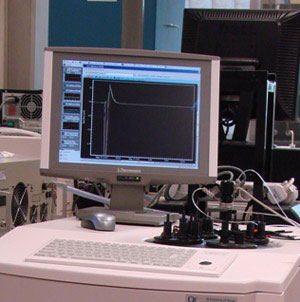| Posted: December 23, 2009 |
A combination of analytical techniques can trace the real-time progression of simultaneous chemical reactions |
|
(Nanowerk News) Chemists must be aware of the heat flow that accompanies their reactions; otherwise, disastrous consequences can occur during practices such as industrial scale-up of chemical production yields. Heat can be experimentally measured with a calorimeter—an insulated vessel that tracks temperature variations. If there are more than two processes occurring within a reaction, however, it is very difficult to separate the total heat change into individual contributions.
|
|
Now, Martin Tjahjono, Effendi Widjaja and Marc Garland from the A*STAR Institute of Chemical and Engineering Sciences in Singapore have combined calorimetry with vibrational spectroscopy—a technique that measures how molecules respond to certain light frequencies—to identify real-time heat evolutions during single and multiple chemical processes ("Combined Online Spectroscopic, Calorimetric, and Chemometric Analysis: Reaction Enthalpy Determinations in Single and Parallel Reactions"). This methodology promises to transform investigations of complex systems; it will also generate safer and more efficient manufacturing routes.
|
 |
| The TAM III microcalorimetry device, equipped with customized flow-through cells, used for the analysis of heat from simultaneous chemical reactions.
|
|
In their proof-of-principle experiment, the researchers studied how a mixture of methyl and ethyl paraben—two aromatic molecules commonly found in cosmetics—reacted with sodium hydroxide in water. Their insulated flow-through system, which continuously pumped the chemical mixture through micro-calorimetry and vibrational spectroscopy instruments (Fig. 1), provided simultaneous and quantitative measurements as the reaction progressed over time.
|
|
With the additional vibrational information, the researchers could perform an analysis technique known as band-target entropy minimization (BTEM). This method breaks down the spectroscopic data into individual, ‘pure-component’ spectra through a series of mathematical transformations. The pure components were then used to calculate the relative concentrations of each molecule in the reaction. According to Tjahjono, BTEM performs very well with vibrational spectroscopy because of its steady, high-quality signals.
|
|
“BTEM has the ability to reconstruct pure-component spectra of constituents that are present in only trace amounts, i.e. at part-per-million levels and below,” says Tjahjono. “It is especially suitable for studying new reactions where many or most of the transient species are being observed for the first time.”
|
|
From the BTEM analysis, the researchers constructed a time-dependent profile that revealed exactly how the parallel components grew or diminished in concentration during the chemical reaction. By comparing the concentration profiles to the calorimetry data, they directly determined the heat flow from the separate methyl and ethyl paraben reactions. This is a critical improvement over other techniques, which rely on difficult-to-verify kinetic models.
|
|
This new method should find wide use from chemists seeking deeper understandings of multifaceted reactions. “We expect to find numerous applications for the new in situ spectroscopy–calorimetry approach, for both in-house projects as well as collaborations,” says Tjahjono.
|

